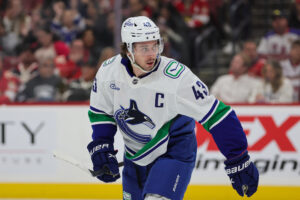If there’s anything good to be had about this pandemic [ed. note: there isn’t] it’s that the Vancouver Canucks injuries to their players have time to heal up and make a difference once the season resumes.
Vancouver Waiting for their Patients
The Vancouver Canucks had mostly avoided their usual slew of injuries, but that wasn’t going to last for an entire season. By the time the league went on hiatus, five regulars were out of commission. While the Canucks can wait for the league to start up again, four or possibly all five could return.
When Your Timing is “Bad” or “None”
Josh Leivo wasn’t having the start to his career he had hoped. Being selected by the Toronto Maple Leafs was excellent, but breaking into the league was something else. After six years he had taken a pay cut, signed a “Show Me” deal, and finally, in 2018-19, he started the year with the big club. The Leafs’ forward depth made it hard to get ice time, and he managed just six points after 27 games.
Then Vancouver came calling.
The move to a team desperate for scoring was just what Levio needed. With middle-six ice time, he added 10 goals and 18 points to his resume over 49 games. For his next deal, he had enough clout to bet on himself. He negotiated a one-year deal that carried him to unlimited free agent status, and a good raise to boot. It was a good bet: he worked well with Bo Horvat, and the team needed a scorer.
It was the right move. With 19 points in 36 games, he was easily reaching career highs. The second line of Leivo-Horvat-Tanner Pearson was providing secondary scoring even in shutdown matches. Which made the season-ending knee injury on December 19th extremely disappointing. The Canucks can wait as long as Leivo’s out before negotiating, while Leivo needs to get back on the ice to prove his value.
Wins and a Huge Loss
After years of trying to live up to his “Best Goalie Not in the NHL” reputation, Jacob Markstrom has solidly established himself as an NHL starter. Not just a starter, but an excellent one, especially given the defensively porous team in front of him. Two straight 60-game seasons put questions of his durability to rest, and his .918 SV% was a career-high.
His year is all the more impressive given the loss of his father and flight back home mid-season. As a 30-year old hitting free agency, Markstrom is ready to hit it big. The Canucks have a succession plan in net, but this season may have put a spanner in the works. When he felt something wrong on a road trip in late February, he was sent back to Vancouver immediately. The team reported he would be out at least two weeks, an announcement not made until a deal was quickly done to shore up the position.
Just as the team was trying to work their way out of a 3-4-2 slump, Thatcher Demko became the starter. They beat the Montreal Canadiens in a shootout, then lost four in a row in regulation. By the time Demko found his footing, the Canucks were out of a playoff spot. Demko wasn’t the problem, but he also wasn’t Markstrom. In a regular year, the Canucks can wait for him. Not this year.
Wow, He’s Doing Really- Oh, Nooooo!
In his rookie season, Chris Tanev was nicknamed “Gumby” because of his ability to take a hit. He was – and is – ridiculously calm, and often waits until the last second to pass the puck out. While it makes for a more sure pass, it also means he takes a lot of hits in the course of a season. He started as Gumby but has ended up more like the frequently-dismembered Mister Bill. In a nine-year career, he’s made it to 70 games once.
Skating alongside super-rookie Quinn Hughes for much of this year, Tanev matched that 70-game season with two goals and twenty points in 69 games. Perhaps his injury in his 69th game should be seen as the odds righting themselves. But there was hope that Vancouver’s best defensive defenceman would survive the year, even into the playoffs.
Compounding frustrations, this is Tanev’s free-agent season, wrapping up a five-year contract. He missed over 100 games in the previous four seasons, and finishing the last year with a full slate would have strengthened his position. As it is, he’ll have to negotiate with the numbers he has – and a new nickname.
The Beagle Has (Crash) Landed
Brought in to solidify the bottom-six and give coach Travis Green another option to line match, Jay Beagle has had mixed results in Vancouver. Critics can point to his atrocious Corsi numbers – the team has about 39% of the shots when he’s on the ice. Supporters can say it’s because he starts 80% of his shifts in the defensive zone, so what do you expect? And that’s about the same Corsi he had when the won the Stanley Cup with Washington, which is one more championship than Vancouver has.
Whether you’re a fan of Beagle’s or not, it’s obvious Green trusts him. When he’s available, Horvat’s line is free to go more offence, which helps the team beyond his ice time. So with him not playing because of a mystery ailment (you can always tell when the playoffs are coming, can’t you?), more pressure is on the captain. And, more to the point, it’s harder to score when one of your scoring lines is on shadow duty.
How Do You Solve a Problem Like Michael?
A regular complaint from Canucks fans in 2018-19 was the lack of protection for Elias Pettersson. Without a tough guy riding shotgun for him, he’s just going to get manhandled by chronically embarrassed defencemen. It becomes more difficult when trying to find a partner that can match Pettersson’s skill: you do NOT want to waste such a prime spot on someone who can’t keep up.
So when Micheal Ferland came available as a free agent, GM Jim Benning moved in. Here was a player who had good speed, some scoring ability, and a fierce temper. While Ferland played stretches on top lines for the Carolina Hurricanes and Calgary Flames, he was usually middle-six. Not a problem: Benning was willing to give those players a chance if he thought they could improve. Leivo is a prime example, as is Pearson. Ferland also had a history of concussions but was given a clean bill of health in the offseason. Risks were there, but it was worth the payoff.
Or not. Ferland lasted on the top line for one game, clearly having some trouble finding his role. His ice time diminished, and he cycled through linemates as Green tried finding a match. If the coach couldn’t, the four-year $14 million deal would be yet another disastrous free-agent signing for Benning.
Signs of hope finally shone through eleven games in. At home to the Florida Panthers, Ferland was active, engaged, and using his speed. He picked up a couple of assists, doubling his point totals for the year. Next game, he dropped the gloves for his first fight and ended his season. He came back after a month and played parts of two more games, but shouldn’t have. The Canucks can wait for him to be fully healed before he tries another return.
Suddenly, Depth!
We’ve talked before about Benning needing to make the playoffs this year. That impetus drove him to sign Ferland and make a risky deal for J.T. Miller before the season started. As the injuries piled up – including one to Brock Boeser – he made another big cut and landed Tyler Toffoli. It was another expensive deal for a rental player: a very good prospect and a second-round pick for a UFA. The Los Angeles Kings took a cumbersome contract deal back to make the money work, but unless the Canucks re-sign Toffoli (costing another pick, this time a fourth-rounder) that’s an awful lot for a very brief time.
Fortunately, Toffoli has been living up to his end and then some. Always a good shooter, lining up with Pettersson and Miller has given him even more opportunities, and he’s been burying them. His six goals and ten points in ten games are as much as anyone could hope for, including him. The price to keep him is going up (probably) but what will happen this year if play resumes is even more interesting.
If fully healthy, the Canucks’ front six would be Miller-Pettersson-Toffoli and Boeser-Horvat-Pearson. With Leivo moving down to the third line, sophomore Adam Gaudette, who’s already got 33 points in 59 games, becomes a bit more dangerous. Add Jake Virtanen, having his own breakthrough with 18 goals in 69 games, and that’s a dangerous set for 12-13 minutes a night. With a half-dozen NHL veterans to fill out the bottom of the lineup, this would be the deepest forward group the Canucks has had in years – possibly ever.
While the Vancouver Canucks can wait patiently for their injuries to heal up, their fans should be chomping at the bit.
Main Photo:
Embed from Getty Images






